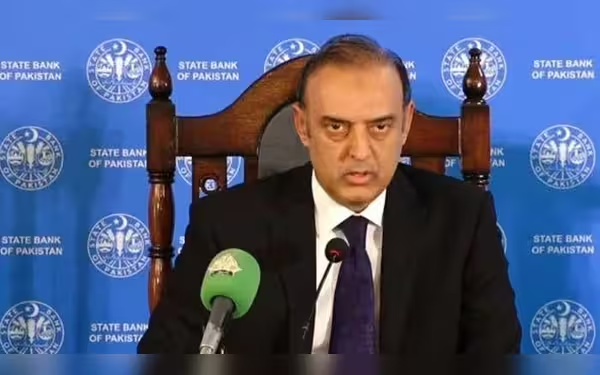Thursday, November 7, 2024 08:33 AM
SBP Interest Rate Cut Leads to Rs1.3 Trillion Savings
- SBP cuts interest rate by 250 basis points to 15%.
- Projected savings of Rs1.3 trillion for the government.
- ADB to disburse $500 million to bolster foreign reserves.
 Image Credits: geo
Image Credits: geoSBP's interest rate cut to 15% is projected to save Rs1.3 trillion, enhancing economic growth and foreign reserves.
The State Bank of Pakistan (SBP) has recently made headlines with its significant decision to cut interest rates, a move that is expected to have far-reaching implications for the country’s economy. Governor Jameel Ahmad announced that this reduction in the key policy rate by 250 basis points to 15% will lead to substantial savings for the government, amounting to approximately Rs1.3 trillion. This figure represents about 1% of Pakistan's gross domestic product (GDP), a notable impact on the nation’s fiscal landscape.
During an analyst briefing, Ahmad explained that the government's total interest expense for the fiscal year 2025 is now projected at Rs8.5 trillion, down from the Rs9.8 trillion initially estimated in the budget. This reduction in interest expenses is crucial as it will help in managing the fiscal deficit for FY25. The SBP's decision to lower interest rates is part of a broader strategy to stimulate economic growth while keeping inflation in check, which has remained in single digits through October.
Ahmad emphasized that the current monetary policy is flexible enough to handle fluctuations in oil prices and other commodities, which can vary by 10-15%. He also highlighted the importance of using surplus funds wisely for debt profiling, which is expected to significantly reduce the government's debt servicing costs in the upcoming fiscal year.
In addition to the interest rate cut, the SBP governor mentioned that the Asian Development Bank (ADB) is likely to disburse around $500 million to Pakistan soon. This influx of funds is anticipated to bolster the country’s foreign exchange reserves, pushing them beyond $11.5 billion, with projections suggesting they could reach $13 billion by June 2025.
Analysts at the briefing noted a positive trend in Pakistan's external position, particularly in the first four months of the current fiscal year. Remittances for October are estimated to exceed $3 billion, which is expected to help reduce the current account deficit to a minimal level for the July-October period. The current account recorded a surplus for the second consecutive month in September 2024, bringing the cumulative deficit down to $98 million in the first quarter of FY25.
Despite a rise in imports, strong remittances and increased exports have played a vital role in containing the deficit. The SBP's reserves have also been bolstered by the receipt of the first tranche under the International Monetary Fund (IMF) loan program, which reached $11.2 billion as of October 25. Furthermore, the SBP purchased $1.3 billion from the interbank forex market in June and July to enhance reserves and manage external debt repayments.
Looking ahead, the SBP has outlined that the total debt repayments for FY25 will amount to $26.1 billion, slightly lower than previous estimates. The government is expected to pay $6.3 billion over the next eight months, with the remainder likely to be rolled over or refinanced. Ahmad addressed concerns regarding the funding gap mentioned in the IMF staff report, clarifying that there is currently no funding gap during the IMF program.
In terms of debt management, the SBP reported a decrease in the overall debt stock, with total external debt falling from $100 billion at the end of FY22 to $98.3 billion by the end of FY24. The maturity profile of these debts has improved, largely due to a higher share of multilateral debts. The domestic debt profile has also seen positive changes, with the share of short-term treasury bills decreasing to 21% in the first four months of FY25, down from 24% at the end of FY24.
As the SBP continues to navigate the complexities of Pakistan's economy, it remains optimistic about the future. The central bank anticipates that real GDP growth for FY25 will exceed previous projections, falling within the range of 2.5% to 3.5%. The IMF also forecasts a growth rate of 3.2% for the country in FY25. With inflation expected to remain relatively low due to improved supply of key food commodities and decreasing oil prices, the SBP is committed to maintaining a monetary policy that supports macroeconomic stability and sustainable economic growth.
While the recent interest rate cut and the anticipated influx of funds from the ADB signal a positive shift for Pakistan's economy, it is essential to recognize that challenges remain. Economists caution that the current recovery may not be sustainable without a comprehensive reform program. As Pakistan moves forward, the focus must be on implementing consistent reforms to ensure a robust economic recovery that benefits all citizens.













